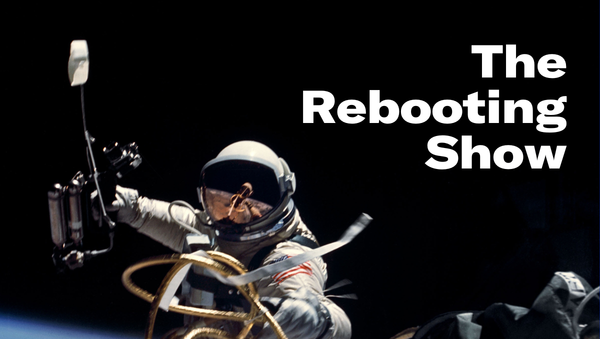How Business of Home found a valuable niche
"There has to be a community to support what you’re doing"
This week’s episode of The Rebooting Show features Julia Noran Johnston, founder and president of the Business of Home, a vertical media company focused on the interior design industry.
I wanted to speak with Julia for a few reasons. I’m always interested in speaking to former journalists who are now running businesses, since I tend to think they build differently than those who come from the sales or operations side. The other reason is the category. B2B is often knocked as boring, but there are many areas that blend consumer elements. The home is one of those.
Julia’s advice for those building new media businesses: “Find your community. There has to be a community to support what you’re doing. Find a place that’s relatively untapped because that gives you the advantage and opportunity for success.”
Here are five key takeaways from the conversation:
Finding your niche
Building a business media brand means finding an underserved audience, ideally one with buying power. In the 2000s, Julia had shifted from journalism to a marketing role at Condé Nast’s Veranda magazine. What she noticed was that many requests for proposals listed interior designers as their target. “They were the volume buyers of the product,” she said. “In some cases, they were 100% of the buying base. I started to realize they were very valuable and what a premium audience that was, and at Veranda we weren’t isolating that audience.”
Community > audience
The most sustainable media brands focus on communities that share an interest and want to connect with each other. That’s why some of the most successful media brands -- Complex (streetwear), Barstool (bros who gamble), Hodinkee (watch collectors) -- are built around communities. Going to many interior design events in New York, Julia recognized that designers were a real community. “I was hanging out with designers, it was a real community that existed and there wasn’t a publication serving that community at all. I saw the opportunity for the community to have a hub.”
Be ready to pivot
The reality of most businesses is the path you plan to take isn’t usually the one you end up taking. For BoH, the initial business plan was built around assembling a database of designers with projects to match with product makers and bloggers covering the space. “It made a lot of sense on paper,” Julia said. But there was a problem: As BoH (then called Editor at Large) grew as a news source, the database business didn’t match since it was a PR play. Inevitably that would dent the credibility of the news content. In 2011, the company changed course. “We started to focus on that more because that’s what people wanted and where the demand was,” Julia said. “It’s much easier to meet demand than push something that people are resistant to.”
Growing a sales team
Getting sales right is critical to any sustainable business. BoH has relied heavily on in-bound leads for advertising, but is now building out its sales team and breaking into new categories. But that comes at a price: The need to add more infrastructure and processes expected by advertisers in these new sectors. “As you grow into new categories of advertisers, you’re learning those industries and what they expect and how they need to be handled differently,” Julia said.
Events as leverage
Just about every B2B media business model includes events. Every community needs to congregate, and events have long served the role of connecting a buy and a sell side. One additional benefit: They can allow a niche media brand to attract larger advertisers. In the first episode of The Rebooting Show, FOS’s Adam White shared how its plan for the Rising 25 awards event helped it attract a $100,000 deal from Anheuser-Busch. For BoH, its Future of Home event was used to secure Google Nest as a sponsor. “It enables us to go to bigger advertisers because if we add everything on our site together it amounts to only so much,” Julia said. “I don’t think [Google Nest] would have given us the time of day if we asked them to buy digital ads on the Business of Home. But to be the title sponsor of the Future of Home conference with 550 people, that captured their attention.”


In the last 20 years advertising media has shifted to a real-time trade, yet the cashflow moves slower than most sectors. The holy grail is matching the velocity of the money to the velocity of the commerce, in an efficient way that optimizes: cost of capital, scalability and risk management. But too many media companies make common financing mistakes:
- Mistake 1: Deploying capital raised from equity to finance operating expenses. Capital infusions are earmarked to growth, but there is a temptation to use some of that liquidity to float outstanding accounts receivable. The result: Slower growth, inefficient use of capital.
- Mistake 2: Relying on an asset-backed loan from a bank. An ABL is an obvious choice but not ideal since 60-90-plus day payment terms often drain the entire facility. Also: stringent covenants and high fees.
Silverblade Partners offers a better way for all media companies to use trade finance to create a strategic advantage.

5 things to check out
All media is becoming performance media. Publishers need to adapt to that reality, writes Troy Young in his latest newsletter edition. Impressions were always a poor proxy for impact, and the mixture of content and commerce is shifting media business models to focus much more on transactions. If software is eating the world, performance marketing is eating media.
Don’t confuse conviction for being close minded. It’s fine to be turned off by the excesses of crypto and still recognize the potential. Adam Davidson chronicles his journey from crypto cynic to a believer and why web3 has so many excited about the possibilities of fixing many of the wrongs of Web 1.0 and Web 2.0. The attention on DAOs (decentralized autonomous organizations) will hopefully open many people to the possibilities -- and yes, for the most part these remain theoretical possibilities as opposed to solid examples. That said, expect to hear more DAOs in the coming months, and it’s becoming clearer how much overlap they have with media membership models.
I’m not ready to pivot to video just yet, but Alex Ragir was kind enough to include me as a panelist in his new video show, The Media Jungle. Along with Mosheh Oinounou, we break down some hot button media stories of the week, including the Portnoy-Insider beef, the pivots to subscriptions and YouTube’s move to remove dislikes. It’s like The Bill Maher Show only different.
Reporters need to stop allowing publications to inflate their self-reported subscriber numbers. The FT is the latest to mix in email subscribers with people paying hundreds of dollars for a subscription, this time in a mini-profile of The Information. A couple nuggets: The Information claims profitability and 49 employees, and its bundling deal with Bloomberg was scrapped.
Farewell to John Durham. John was a key figure of the emerging internet advertising industry from the start. He passed away last week, and I’ve been struck in the outpouring of remembrances of how often people speak of how John was decent and fair to everyone. Matching actions to words is always a good approach. He’ll be missed.

Thanks for reading this week. I always like hearing from TRB subscribers, so drop me a note with any feedback: bmorrissey@gmail.com. (You can also hit reply on this email.)




